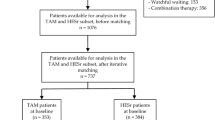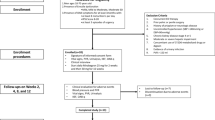Abstract
This prospective, controlled study was undertaken to evaluate the early urodynamic and symptomatic impact of the lipido-sterolic extract of Serenoa repens (Permixon® ) in the treatment of patients with benign prostatic hyperplasia (BPH).
A total of 75 patients, aged 52–78 y with lower urinary tract symptoms due to mild/moderate BPH (mean International Prostate Symptom Score (I-PSS) 8.2) were included in the study, of which 57 received Permixon® 160 mg twice daily for 9 weeks. Urodynamic evaluation, including maximum urinary flow rate (Qmax) and detrusor pressure (DP), was performed at baseline and endpoint. Prostate volume and post-void residual urine volume were assessed by transrectal and transabdominal ultrasound respectively. In addition, the I-PSS and its associated quality of life (QoL) score were determined and adverse events were recorded.
Baseline parameters were comparable between the active treatment and control groups. After 9 weeks of Permixon® treatment Qmax increased (6.0%, P<0.001), and there were reductions in DP at maximum flow (12.8%, P<0.001), opening DP (12.6%, P<0.001), and residual urine volume (12.6%, P<0.05). In addition, the I-PSS and QoL score both decreased significantly from baseline in the active treatment group (26.8% and 18.2% respectively, P<0.001). None of these parameters improved significantly in control patients. There were also improvements in prostate volume (2.7%) and maximum DP (5.2%) in the Permixon® group which did not reach significance. Three patients receiving Permixon® experienced gastrointestinal disturbances but these did not lead to withdrawal or require additional therapy.
In patients with mild/moderate BPH, Permixon® treatment reduced infravesical obstruction and produced a rapid improvement in urodynamic parameters and symptoms. The drug was well tolerated. These data support the use of Permixon® as first-line therapy in patients with uncomplicated symptomatic BPH.
This is a preview of subscription content, access via your institution
Access options
Subscribe to this journal
Receive 4 print issues and online access
$259.00 per year
only $64.75 per issue
Buy this article
- Purchase on Springer Link
- Instant access to full article PDF
Prices may be subject to local taxes which are calculated during checkout
Similar content being viewed by others
Author information
Authors and Affiliations
Corresponding author
Rights and permissions
About this article
Cite this article
Al-Shukri, S., Deschaseaux, P., Kuzmin, I. et al. Early urodynamic effects of the lipido-sterolic extract of Serenoa repens (Permixon®) in patients with lower urinary tract symptoms due to benign prostatic hyperplasia. Prostate Cancer Prostatic Dis 3, 195–199 (2000). https://doi.org/10.1038/sj.pcan.4500477
Received:
Revised:
Accepted:
Published:
Issue Date:
DOI: https://doi.org/10.1038/sj.pcan.4500477
Keywords
This article is cited by
-
Hexanic Extract of Serenoa repens (Permixon®): A Review in Symptomatic Benign Prostatic Hyperplasia
Drugs & Aging (2022)
-
S2e-Leitlinie der Deutschen Urologen
Der Urologe (2016)
-
Quality of life in patients with lower urinary tract symptoms associated with BPH: change over time in real-life practice according to treatment—the QUALIPROST study
International Urology and Nephrology (2016)



